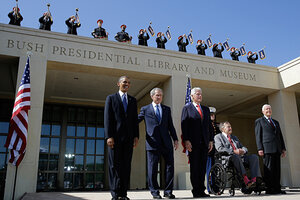George W. Bush on the rebound? Nothing like a presidential library to help.
George W. Bush, his approval rating already on the rebound, opens his new presidential library to good reviews, and with all four other living presidents in attendance.

From left, President Barack Obama, former President George W. Bush, former President Bill Clinton, former President George H.W. Bush, and former President Jimmy Carter arrive for the dedication of the George W. Bush Presidential Center on Thursday, in Dallas.
David J. Phillip/AP
Can a library redefine a presidency?
If George W. Bush’s new library is any indication, you bet.
Like memoirs and a sudden interest in Third World health issues, presidential libraries are one of the many devices in the grand toolbox of “Post-Presidential Image Rehabilitation.” In other words, rewriting history.
In fact, the George W. Bush Presidential Center, which is enjoying a Grand Old Party of an opening Thursday as all five living presidents descend on the Southern Methodist University in Dallas for its dedication, has actually gotten some good reviews.
The Daily Beast calls it “bold,” “honest,” “gracious,” “respectful,” and “humble.” (Oh wait, that’s Mark McKinnon, former Bush media adviser, writing for the site.)
In all seriousness, we’ve got to hand it to Dubya – and what must be one of the most practiced PR teams in history – on this one. From what we’ve seen and heard, the library comes across as a thoughtful tribute to a nation.
And, thanks to the above-mentioned PR team, the broader image rehab project is already working. A Washington Post-ABC News poll released Tuesday showed Bush’s approval rating has climbed to 47 percent, up from a bruising 23 percent when he left office.
The presidential library in Dallas and its version of the Bush years, along with a healthy dose of amnesia, can only help.
Here’s how Bush – according to his brand spanking new library – wants to be remembered:
As a wartime president
Looming large in the center of the museum is a mangled steel beam from the World Trade Center, dramatically showcasing the 9/11 attacks, and by extension, Bush’s leadership as a wartime president. It’s no surprise this is a focal point of the Presidential Center – 9/11 was a turning point not only for the presidency, but also for the nation. Echoing across the library are the wails of the sirens that blared on 9/11 and, according to Politico, Bush bellowing, “Today our nation saw evil.”
… But a statesman, not a warmonger
He may be a wartime president, but he’s no warmonger, Bush’s library wants you to think. The wars in Iraq and Afghanistan are largely downplayed, folded into one display on the Global War on Terror in an exhibit called, in classic Bush fashion, “Defending Freedom.” (Not to be confused with Operation Enduring Freedom, Operation Iraqi Freedom, or the Bush Freedom Agenda.)
And while Bush wasn’t the most refined of statesmen, perhaps, (remember the German Chancellor neck rub, the African dance party, and the Saudi sword dance?), as Politico points out, the first thing greeting visitors at the Bush theater is an oversize painting of him with former British Prime Minister Tony Blair.
As a compassionate conservative
You won’t find a whole lot of politics or election memorabilia in the Bush library. (Notably, not a whiff of the controversial, and oft-caricatured, figures of Senior Adviser Karl Rove, Secretary of Defense Donald Rumsfeld and Vice President Dick Cheney.) Nor will you find any reminders of Bush’s staunch opposition to gay marriage and abortion – positions that may not stand the test of time.
What you will find is a case for Bush as a compassionate conservative, with big displays on his more overlooked causes like No Child Left Behind, the faith-based initiative, and his campaigns to encourage volunteerism and to fight AIDS and malaria in Africa.
As the mid-range department store so aptly put it, it’s the softer side of Bush.
As a resolute leader who faced difficult decisions
There was a lot of controversy in the Bush years – from WMDs and the Iraq invasion to Hurricane Katrina – and the library’s handling of it was masterful.
Rather than ignoring the controversy (too obvious) or glorifying Bush’s agenda (too vulnerable), the presidential center decided to put visitors in Dubya’s shoes, shedding light on the enormity of the decisions he faced.
That’s how the “Decision Points” theater was born, an interactive experience in which guests consider four major dilemmas Bush faced – the Iraq invasion, the troop surge, the response to Hurricane Katrina, and the financial crisis – and based on advice from advisers, choose their own response. Bush then appears on a video explaining his own decisions and how he arrived at them.
Given the sensitivity of the issues explored, this little device is brilliant.
As is Bush’s fifth decision: to take a page from Winston Churchill’s book on securing his legacy.
“History will be kind to me for I intend to write it,” the British prime minister once said.


